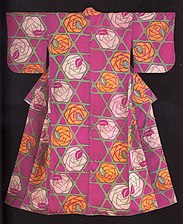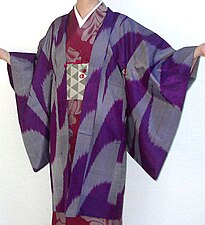Meisen (textile)
This article has multiple issues. Please help improve it or discuss these issues on the talk page. (Learn how and when to remove these template messages)
|

Meisen (銘仙, lit. 'common silk stuff') is a type of
The fibre used for meisen is
Materials, spinning and weaving
Silk naturally comes in extremely long filaments (more than a kilometre and a half long), one per
Traditionally, the noil was joined by hand-plying the ends
As the textile industry in Japan industrialized in the late 19th century, large amounts of silk were produced for export.
Meisen was spun tightly, with many more twists per unit length. It is stiff and crisp, with a glossy, hard, resilient surface, and wears well.[14][15]
Later, cloth made from blends of other fibers, but with similar properties or social roles, was sometimes marketed as meisen.
Dyeing and patterning
-
Kimono, stencil-printed warp, with a notablyArts and Craftslattice-and-rose motif, 1912 to 1926
-
Kimono, stencil printed on warp and weft
-
Stencil-printed meisen kimono, chrysanthemum pattern
-
Stencil-printed haori
-
Meisen haori over a more subdued kimono.
-
Kimono withpaper cranes (origami), portrayed in Western perspective
Meisen was generally dyed with bright new
Initially, meisen was produced in plain colours or simple stripes.[13] Later, it came to be dyed by kasuri (Japanese ikat).
While traditional kasuri involved tying bundles of threads and dying them by hand, meisen was often patterned using less labour-intensive techniques. These produced kasuri-style blurred edges to the patterns, but with lower labour costs than hand-tying.
These thread-dying techniques produce a double-sided pattern,[5] unlike painting or printing cloth, so when a meisen garment begins to show wear on the outside, it can be resewn with the panels flipped inside-to-out.[16]
Patterns on meisen are often somewhat mismatched,

Industry
The market was highly competitive and had a rapid pace of technical innovation. New designs were produced each season, and advertised as defining specific "looks" and social meanings; department store requested specific patterns, made fashion forecasts, and gave marketing advice. Networks of wholsalers at various geographic scales formed.[17]
After the military, the textile industry lead Japanese industrialisation. Initially, there were government subsidies and substantial government ownership. In 1882, government had just begun to privatise major enterprises, and textile mills made up half of private factories and employed 2⁄3 of factory workers. Textile workers increasingly became mostly female. In the Taishō period, many workers were daughters of well-off farm families and the former ruling class, but later they came mostly from poor peasant families.[17]
-
A store selling meisen, 1930
-
Another Ashikaga advertising poster, 1928; Art Nouveau-influenced pattern[17]
Use and survival
Meisen was a fairly cheap cloth, used for clothing, noren curtains, futons, and zabuton (cushions).[17][13] In the 1870s, meisen was worn by geisha for informal gatherings.[18]
Meisen garments were often lined with lightweight cloth, from cheaper fibres like
Cheap, bright, hard-wearing meisen kimonos boomed during the economic downturn.[19] It is estimated that, in the late 1920s, over 70% of Japanese women owned one or more.[19]
Meisen was extremely popular in its day, especially among newly-financially-independent women, before abruptly going out of fashion.
See also
- Tanmono, the traditional bolt of cloth used for making kimono
- Kasuri, traditional Japanese ikat dyework
- slubbynoil cloth.
References
- ISBN 978-88-572-0011-8.
- ^ a b c d e f g h i j k l m n o "Komon and Yukata". Kimono mochi: kimono collection.
The lowly komon kimono is the workhorse of the kimono wardrobe, worn for trips to town, to friends houses, in any situation which is outside of the home but informal. Despite their name, which means 'small design', komon can have large or small imagery, and the repeat can be staggered widely. painted, closely stencilled, woven, Printed, striped, spotted, shibori, silk, jinken, modern polyester--if it's a repetitive design, short-sleeved, and without kamon, then it's a komon. [this quote is given as the title in the metadata]
- ^ a b c d e f g "From the collection of Haruko Watanabe: MEISEN — nancyprice". nancypricestudio.ca. Retrieved 5 April 2022.
- ^ a b "Kimono Mochi: private kimono collection photographs and text". kimonomochi kimono collection. Retrieved 31 July 2021.
- ^ a b c d e f "The Meisen Kimono Exhibit". the ikebana shop. 25 September 2014.
- ^ a b "Khalili Collections | Japanese Kimono | Kimono for a Woman". Khalili Collections.
- ISBN 9780099428992.
the cloth that peasants wove for themselves from the broken filaments of wild cocoons after the moths had emerged, or from the leftovers of the cultivated crop that had been spoiled or broken by hatching the seed moths that would lay the eggs for the next season's crop of silkworms.
- ^ Ruth M. Shaver (1966). Kabuki Costume. Tuttle Publishing).
- ^ "Ojiya tsumugi silk". KOGEI JAPAN.
- ^ Dusenbury, Mary (1992). "A WISTERIA GRAIN BAG and other tree bast fiber textiles of Japan". Textile Society of America Symposium Proceedings. Retrieved 12 June 2021.
- ^ "UNESCO - Intangible Heritage Home". ich.unesco.org.
A yarn [sic][for tsumugi] should be spun by hand out of silk floss. A hard twist yarn cannot be used
- ^ "UNESCO - Yuki-tsumugi, silk fabric production technique". ich.unesco.org.
- ISBN 9780099428992.
a flat hard-finish silk
- ^ Salz, Anji (4 July 2016). "Chichibu Meisen Museum & Nassen dyeing". SALZ Tokyo.
- ^ a b c d e f g Iwamoto Wada, Yoshiko (1 January 1998). "Starlets and Masters: Meisen Posters Published by the Textile Makers". Textile Society of America Symposium Proceedings. From Creating Textiles: Makers, Methods, Markets. Proceedings of the Sixth Biennial Symposium of the Textile Society of America, Inc. New York, NY, September 23–26, 1998 (Earleville, MD: Textile Society of America, Inc., 1999).
- ISBN 9780099428992.
Whereas in the 1870s striped meisen [...] or, in summer, thin ikat kasuri had been acceptable for a geisha to wear to an informal afternoon gathering, by 1900 such fabrics had become déclassé.
External links
- Meisen Kimono exhibit at the Anna Leonowens Gallery, Haruko Watanabe's collection Archived 6 June 2015 at the Wayback Machine
- Photogallery of meisen garments from that exhibit: "From the collection of Haruko Watanabe: MEISEN". nancypricestudio.ca. Retrieved 5 April 2022.








![Another Ashikaga advertising poster, 1928; Art Nouveau-influenced pattern[17]](http://upload.wikimedia.org/wikipedia/commons/thumb/9/9c/Poster_of_Ashikaga_Hon-Meisen_by_Kitano_Tsunetomi.jpg/136px-Poster_of_Ashikaga_Hon-Meisen_by_Kitano_Tsunetomi.jpg)